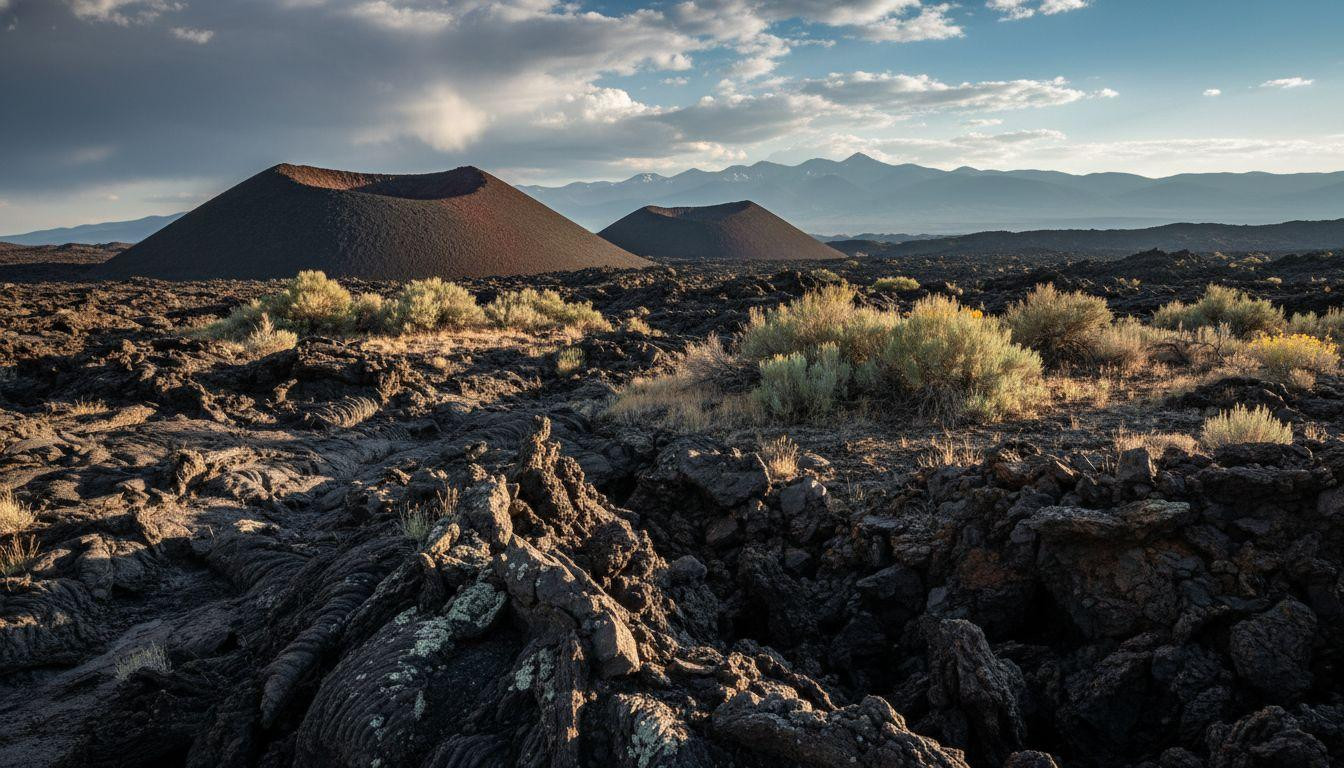Standing on jagged black basalt as dawn breaks over Idaho’s high desert, you witness a landscape so alien that NASA trained Apollo astronauts here in 1969. Craters of the Moon National Monument stretches across 750,000 acres of volcanic terrain, where complete silence meets crystalline night skies and over 400 lava tubes tunnel into absolute darkness. This otherworldly preserve receives just 40,000 annual visitors while millions crowd Yellowstone hours away, leaving one of America’s most dramatic geological wonders quietly waiting for discovery.
Where Idaho’s desert becomes another planet
The transformation begins 18 miles southwest of Arco, Idaho’s single-stoplight town. U.S. Route 20 carries you across sagebrush plains until black rock suddenly dominates the horizon. The 7-mile Loop Road winds through what geologists call a “frozen sea” of lava, where 15,000 years of volcanic history lies exposed under crystalline high-desert air.
At 5,000 to 6,500 feet elevation, the monument occupies a unique position on the Snake River Plain. Boise sits 150 miles northeast (three hours by car), while Salt Lake City lies 190 miles south. The isolation feels profound when you step from your vehicle onto razor-sharp basalt and realize this isn’t typical American wilderness.
The Great Rift, a 52-mile crack in Earth’s crust, created this landscape through eight major eruption episodes. What strikes visitors immediately is how fresh everything appears compared to older volcanic sites. The raw geological time made visible here rivals any remote wilderness experience.
The volcanic landscape NASA chose for moon training
15,000 years of frozen fire
Sixty distinct lava flows created the monument’s current appearance, with the youngest formations dating back just 2,000 years. This makes Craters of the Moon one of North America’s most recent major lava fields. The terrain displays two distinct textures: jagged a’ā lava that tears hiking boots, and smoother pāhoehoe formations that ripple like frozen ocean waves.
More than 25 volcanic cones punctuate the landscape, including outstanding spatter cone examples. The Kings Bowl and Wapi lava fields demonstrate how recently this “alien” terrain formed, appearing fresh and unweathered despite millennia of high-desert conditions.
When astronauts walked on Idaho before the moon
NASA’s 1969 decision to train Apollo astronauts here validated what visitors instinctively sense: this genuinely resembles another world. The combination of stark terrain, profound silence, and otherworldly visual character provided ideal preparation for lunar surface missions. Recent visitor testimonials describe feeling “instantly transported to a surreal landscape reminiscent of the moon’s surface.”
The space agency’s recognition continues today, with potential connections to upcoming 2025 lunar missions being discussed by monument officials.
Four moments that define the monument
Ascending Inferno Cone at golden hour
The quarter-mile hike up Inferno Cone challenges visitors with a steep 10% incline, gaining 430 feet of elevation. The summit rewards effort with 360-degree panoramic views of black lava ocean stretching to distant mountain ranges. Late afternoon light transforms the volcanic rock from deep black to amber and gold.
Visitors consistently describe this viewpoint as the moment they understand the monument’s true scale. The vast geological drama becomes clear when viewed from above.
Descending into absolute darkness
Indian Tunnel and Buffalo Cave offer the most accessible lava tube explorations. Inside these formations, temperatures drop from scorching 85°F surface heat to cool 45°F cave interiors. Some tubes maintain ice deposits year-round despite desert conditions above. Complete darkness requires headlamps for safe navigation through passages that once channeled molten rock.
The mineral scent and acoustic void create sensory experiences unlike typical cave systems. These underground cathedrals carved by lava provide cool refuge from intense desert sun.
The dark sky sanctuary where stars overwhelm
International Dark Sky Park designation recognizes the monument’s exceptional astronomical conditions. At 5,000-plus feet elevation with zero light pollution, the Milky Way appears in overwhelming detail to naked-eye observers. Rangers conduct regular Star Parties with telescope viewings and night sky education programs.
Full Moon Hikes along Devils Orchard Trail create spiritual experiences, with moonlight casting dramatic shadows across jagged lava formations. The cosmic perspective gained from seeing thousands of stars above volcanic foreground transforms visitors’ understanding of geological and cosmic time scales.
Your questions about Craters of the Moon answered
When should I visit and what does it cost?
Admission to Craters of the Moon remains completely free, with no entry fee required. Late September through early November offers optimal conditions: stable weather, comfortable 50-70°F daytime temperatures, minimal crowds, and excellent stargazing clarity. Summer heat creates scorching lava surface temperatures exceeding 95°F. Winter brings profound solitude, though Loop Road closes to vehicles during snow season.
How does this compare to famous parks?
The monument receives approximately 40,000 annual visitors compared to Yellowstone’s 4 million, ensuring genuine solitude. Free access contrasts with Yellowstone’s $35 vehicle pass. The geological experience differs completely: raw volcanic terrain versus geothermal features. Both destinations sit within three hours of Boise, making Craters the overlooked alternative for road trip itineraries.
What makes the caves special?
Over 400 documented lava tubes formed when flowing lava created channels, then surface layers cooled while interior lava drained away. These formations preserve ice year-round in some tubes despite desert surface conditions. Indian Tunnel offers free, self-guided access, while Buffalo Cave requires more challenging navigation skills and headlamp equipment.
November sunset ignites black lava fields amber while profound silence envelops the volcanic landscape. Stars emerge in darkening sky above primordial terrain where Earth reveals its raw power. Craters of the Moon offers what crowded parks have lost: genuine encounters with geological time, absolute solitude, and timeless wonder, all waiting free of charge 18 miles from civilization’s single stoplight.
